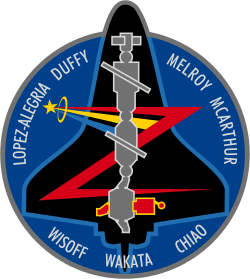Koichi Wakata
| Koichi Wakata | |
|---|---|
 | |
| JAXA Astronaut | |
| Statsborger | Japan |
| Nationalitet | Japan |
| Status | Aktiv |
| Født | 1. august 1963 Ōmiya, Saitama |
Andet arbejde | Ingeniør |
| Uddannelses- sted | Kyushu Universitet |
Tid i rummet | 21 døgn og 20 timer |
| Udvælgelse | NASA-gruppen fra 1992 |
| Mission(er) | STS-72, STS-92 Næste STS-119, ISS Ekspedition 19, STS-127 |
| Missionsemblemer | |
Koichi Wakata (若田 光一 Wakata Kōichi, født 1. august 1963 i Ōmiya, Saitama) er JAXA astronaut og har fløjet to rumfærge-flyvninger.
Koichi Wakata er udvalgt til at være flymaskinist på Den Internationale Rumstation besætning ISS Ekspedition 19 og transporteres dertil med rumfærge-flyvningen STS-119.
Eksterne henvisninger
- Biografi fra NASA Arkiveret 13. marts 2009 hos Wayback Machine
| Spire Denne artikel om rumfart er en spire som bør udbygges. Du er velkommen til at hjælpe Wikipedia ved at udvide den. |
|
Medier brugt på denne side
Japan Aerospace Exploration Agency (JAXA) astronaut Koichi Wakata, flight engineer
Expedition 19 marks the final planned period of three person occupancy, prior to increasing the crew size to 6, and occurs in the final stages of International Space Station assembly. The patch emphasizes the earth, one of the major focuses of attention and study from the orbital research outpost. The design is stylized to highlight the beauty of the home planet and the station orbiting it, next to the sun now the unquestioned 'brightest star in the sky' as viewed from earth.
A drawing of NASA's Space Shuttle Challenger. Image provided by Dryden Flight Research Center at Edwards Air Force Base, California. See [1], specifically EG-0076-04.eps.
Designed by the crew members, the STS-92 patch symbolizes the second mission to carry U.S.-built elements to the International Space Station (ISS) for assembly. The black silhouette of the Space Shuttle Discovery stands out against the deep blue background of space in low Earth orbit. In the foreground in gray is a profile view of the ISS as it appears when the shuttle and crew arrive, with the station consisting of the Unity node, its two pressurized mating adapters (PMA), the Zarya functional cargo block, the Zvezda service module, and the Progress cargo vehicle.
Following the shuttle's rendezvous and docking, the ISS configuration will be augmented by the two elements delivered by Discovery–the Z1 truss and PMA-3. These two elements, depicted in red, will be installed using the shuttle's robot arm and be connected to ISS during four spacewalks. The multi-national nature of both the STS-92 crew and the ISS are reflected in the multi-colored Astronaut Office symbol.
The shape of the STS-119/15A patch comes from the shape of a solar array viewed at an angle. The International Space Station (ISS), which is the destination of the mission, is placed accordingly in the center of the patch just below the gold astronaut symbol. The gold solar array of the ISS highlights the main cargo and task of STS-119/15A -- the installation of the S6 truss segment and deployment of S6's solar arrays, the last to be delivered to the ISS. The surnames of the crew members are denoted on the outer band of the patch. The 17 white stars on the patch represent, in the crew's words, "the enormous sacrifice the crews of Apollo 1, Challenger, and Columbia have given to our space program." The U.S. flag flowing into the space shuttle signifies the support the people of the United States have given our space program over the years, along with pride the U.S. astronauts have in representing the United States on this mission.
STS-72 Mission Insignia






